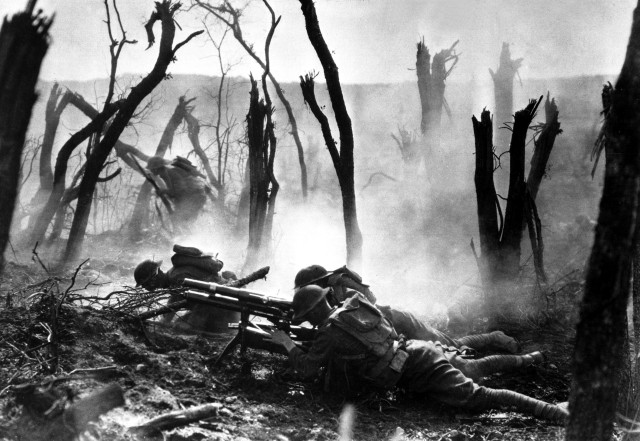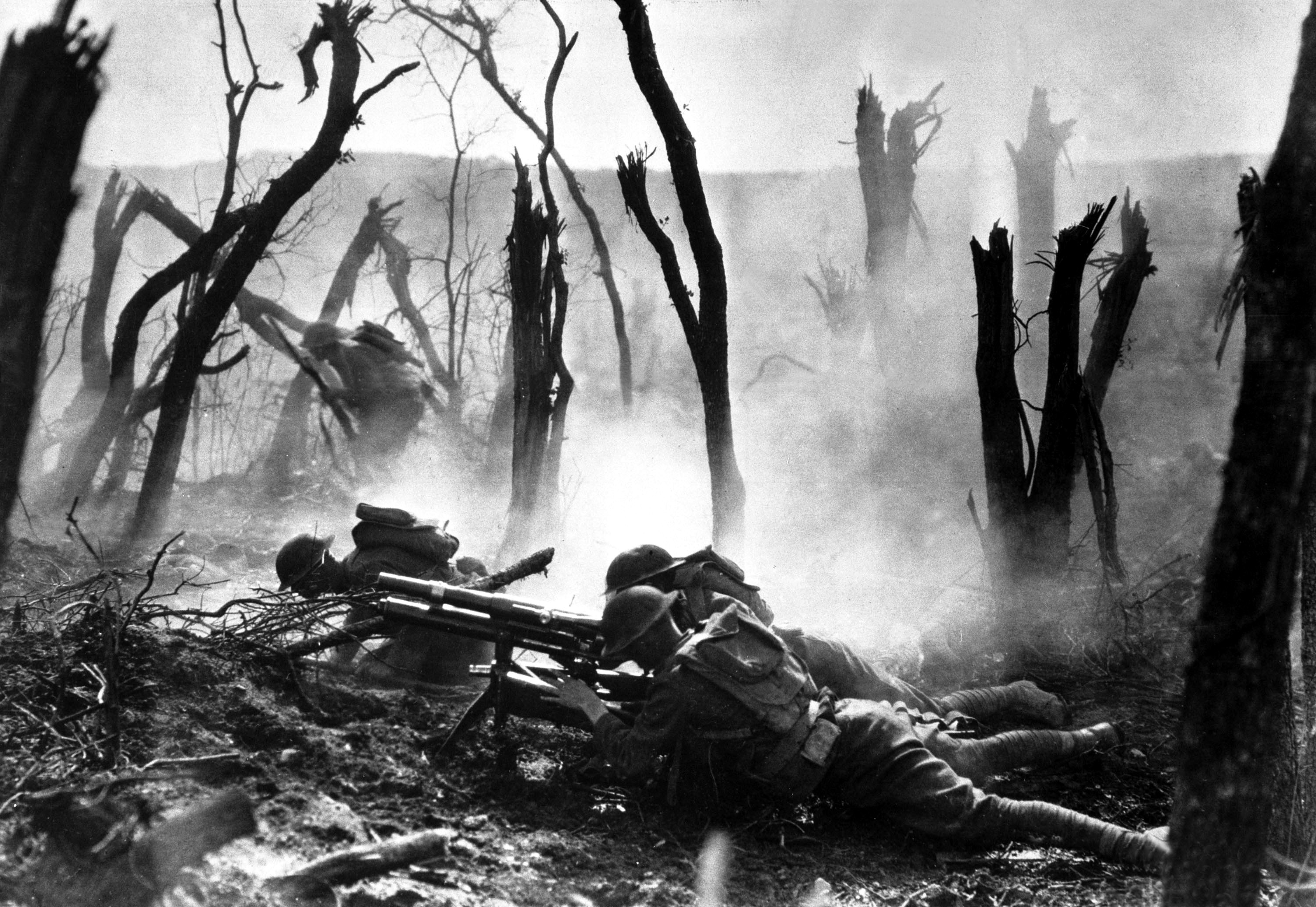
CHATEL-CHAfaEURoHAfaEURoRY, France -- Ninety years ago Soldiers of the Allied Forces under the command of French Gen. Ferdinand Foch began their last major assault of World War I against the German army in eastern France.
According to Foch's plans, "The Grand Offensive" of 1918 would deprive the well-dug-in German Imperial army the opportunity to shift its reserve forces and cut the enemy's supply and communications lines between their occupied territory and Germany.
The American Expeditionary Force's 1st Army, under the command of Gen. John "Blackjack" Pershing and later, Gen. Hunter Liggett, would push north while the 2nd, under the command of Gen. Robert Lee Bullard, would push to the east.
The Grand Offensive included the following separate battles:
Aca,!Ac Meuse-Argonne Offensive launched by the American Expeditionary Force, Sept. 26
Aca,!Ac Operations in the Champagne province by the French IV Army, Sept. 26
Aca,!Ac Battle of the Canal du Nord by the British Expeditionary Force's 1st and 3rd Armies, Sept. 27
Aca,!Ac Battle of St. Quentin Canal by the BEF's 4th Army, Sept. 29
Aca,!Ac Fourth Battle of Ypres by the BEF's 2nd Army, French and Belgian forces, Sept. 28
"More than 1.2 million U.S. Soldiers launched the war's largest-ever attack along the Meuse -Argonne," said Lt. Col. Douglas Mastriano, chief of the NATO Allied Land Component Command Headquarters intelligence division and cofounder of the Sergeant York Discovery Expedition during Oct. 4 ceremonies honoring Medal of Honor recipient Sgt. Alvin C. York.
"During the Meuse-Argonne Offensive the United States suffered about 20,000 casualties a week, as the German army threw everything they could to stop us," he said. "However, at great cost, the U.S. "doughboys" broke the German line and ultimately ended the war."
Pershing's intent for the Meuse-Argonne campaign was clear and simple: draw out the enemy's reserve divisions, cut the two railroads that served as the Germans' primary supply lines, and attack to the northeast through the Argonne Forest toward the city of Sedan.
The German army was ready. Its defenses included exploiting the forest's difficult terrain and numerous east-to-west ridge lines.
The U.S. offensive began Sept. 26 at 2:30 a.m. with a three-hour, 2,700-gun barrage of the German lines. Following the barrage, the Americans began their attack at 5:30 a.m.
York and the 82nd Infantry Division fell under 1st Corps command and control on 1st Army's western boundary. V Corps' 92nd, 37th, and 79th Infantry Divisions pushed forward in the center, while III Corps took the eastern flank.
According to former V Corps historian Charles E. Kirkpatrick, V Corps, under the command of Maj. Gen. George H. Cameron, faced stiff resistance, slowing its advance near the town of Montfaucon.
"The corps finally took its first-day objectives on day three of the attack, primarily as a result of the brilliant fighting of the 91st Division, but the slow pace of the advance gave the Germans time to bring reinforcements up to the front, with six infantry divisions arriving by 28 September to bolster the defenses," Kirkpatrick wrote.
Although unsuccessful in capturing their objectives, V Corps forced the Germans to move their reserve units into battle. The corps' battle-weary divisions were rotated off the line Oct. 4 and replaced by the veteran 1st, 3rd, and 32nd Divisions, with the 42nd Division in corps reserve.
The first four days of the attack went well, according to Kirkpatrick, but the corps was again bogged down by enemy resistance. Cameron was replaced by Maj. Gen. Charles P. Summerall Oct. 12 and the experienced 42nd and 32nd Divisions, with the 89th Division assigned to the corps.
"Summerall was the right choice to command the corps at a difficult moment; an artillery officer with a considerable reputation for innovation and aggressiveness, Kirkpatrick said. "Disdainful of enemy fire himself, he expected similar behavior of his commanders and staff and was quick to relieve any officer he saw as incompetent, hesitant or shy under fire."
As former commander of the 1st Infantry Division's 1st Field Artillery Brigade, "Summerall had developed infantry-artillery coordination to a fine art," Kirkpatrick said.
Despite the limitations of World War I-era communications technology, the new corps commander developed new tactics for the offensive. By Oct. 21, the corps plowed through three lines of German defenses and was ready to overrun the fourth and last.
V Corps launched its attack Nov. 1 with the 89th, 1st and 2nd Infantry Divisions and broke through by noon. The Germans began to withdraw with the U.S. forces in pursuit.
The 1st Infantry cleared way for the French XVII Corps' capture of Sedan Nov. 7. The next day, V Corps units began crossing the Meuse River and continued their advance until Nov. 11, the last day of fighting in World War I.
To learn more about V Corps history, visit: http://www.vcorps.army.mil/references/history_nov2001.pdf
Source: V Corps History, Charles E. Kirkpatrick, November 2001.
Meuse-Argonne Offensive facts:
Days of battle 47
U.S. troops engaged: 1.2 million
U.S. causalities: 120,000
Guns used in the attack: 2,417
Artillery rounds fired: 4.2 million
Airplanes used: 840
Tons of explosives dropped: 100
Tanks used: 324
Miles penetrated into enemy lines: 34
Territory taken: 1,550 square kilometers
Villages and towns liberated: 150
Prisoners taken: 16,059
Artillery pieces captured: 468
Machine guns captured: 2,864
Trench mortars captured: 177
Source: The Official Record of the United States' Part in the Great War, compiled by the Adjutant General's Office; http://statelibrary.dcr.state.nc.us/WWI/OfficialRecord.htm.
Related Links:
'Victory Corps' played vital role in Meuse-Argonne Offensive of World War I

Social Sharing